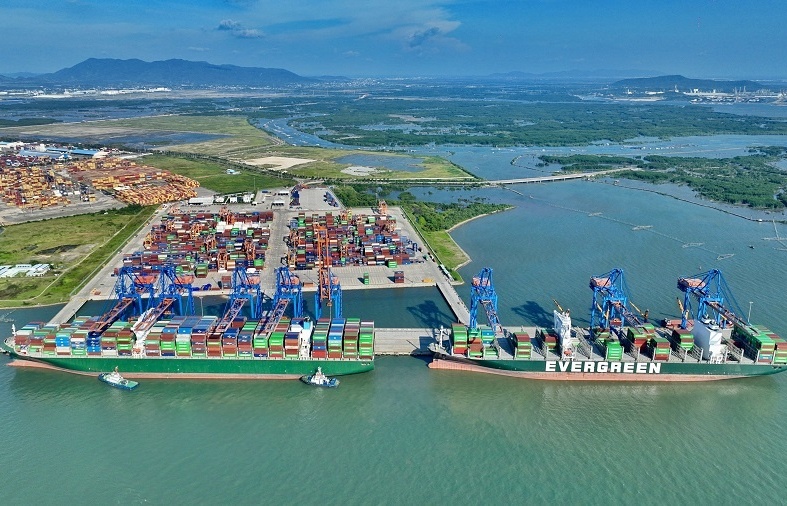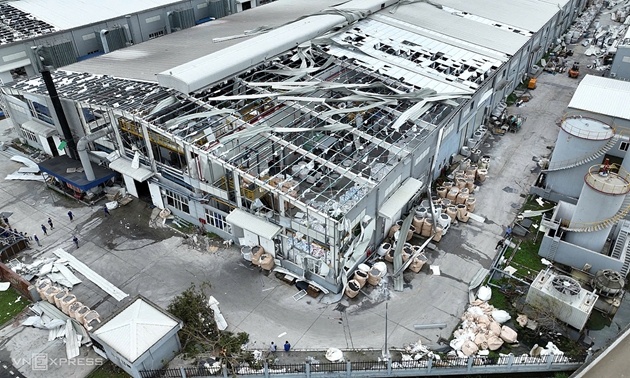Taking stock of Vietnam post-Doi moi

| Eric Sidgwick - Country Director for Asian Development Bank in Vietnam |
|
From one of the poorest countries in the world, Vietnam’s GDP per capita has increased six times over this period, while reducing the poverty rate from over 58 per cent in 1993 to just about 3 per cent today. Dramatic improvements in the country’s economy, in turn, have contributed to a steady progress of social development, and allowed the country to achieve the Millennium Development Goal of eradicating extreme poverty and hunger much earlier than the global target. If we are to look at Vietnam’s economic success since the adoption of Doi moi in 1986, I am sure everyone would agree that creating an enabling environment for business, promoting the private sector as an important engine of growth, reforming the state-owned enterprises (SOEs), deepening financial sector reform, and improving competitiveness have been at the core of the overall strategy. As we have recommended to the government, accelerating SOE reform will reduce risks and support growth by improving the allocation of resources. While the authorities have made progress, further efforts are needed to accelerate implementation and improve co-ordination of the reform agenda, which is fragmented over different agencies and ministries. The government also needs to strengthen finance sector supervision and develop a deeper and more diversified domestic finance system capable of mobilising funds for investment, including for critical infrastructure. Vietnam has achieved rapid economic growth over the past two decades, but to meet the goals of the socio-economic development strategy, more needs to be done. On the policy front, while great strides in reform have been made, the government recognises that there remains a substantial unfinished policy agenda. Meanwhile, increasing global economic integration creates opportunities, but also brings with it risks that need to be mitigated. The institutional capacity to manage reform and mitigate risks will need to be developed. As Vietnam is preparing for the new reform strategy for the next five years, the Asian Development Bank (ADB) is also working on a new country partnership strategy for the same period. Our intention is to fully align the strategy with Vietnam’s Socio-economic Development Plan 2016-2020, so that we will be able to respond to Vietnam’s emerging needs most effectively. ADB stands ready to strengthen our partnership with Vietnam. |
| Nguyen Thi Le Hoa - Deputy Country Director for Oxfam in Vietnam |
|
GDP per capita has increased more than twenty-fold from $100 in 1990 to $2,300 in 2015. Over the past 30 years, Vietnam has amended its constitution three times to move it closer to its goals of prosperity for its people, a powerful country, and a democratic, equal, and civilised society. However, there are many challenges ahead. Most notably, income inequality is increasing as measured by the Gini index (0.32 in 1993 up to an average of 0.42 today, which is higher than in OECD countries (average 0.31). Today, the richest 10 per cent of the population earn on average 15 times more than the poorest 10 per cent. Among ethnic minorities, the incidence of poverty is as high as 59.2 per cent, compared to 9.9 per cent for Kinh and Hoa groups. The gap between the very wealthy and most Vietnamese remains conspicuous. Vietnam was estimated to have 116 super rich in 2014, up from 35 super rich in 2004, owning $20 billion, equivalent to 12 per cent of Vietnam’s GDP. Another type of inequality – inequality of voice and opportunities – is perhaps the most worrying form of inequality in Vietnam, particularly among rural and poorer people (Oxfam study). There is a widening gap in access to quality education, which creates a disparity in equal employment opportunities, ultimately leading to divergent paths for future generations. |
| Jonathan Dunn - Resident Representative of the International Monetary Fund in Vietnam |
|
One of the world’s poorest countries at the onset of its reforms, Vietnam has now reached lower middle-income status, while reaching many socio-economic milestones, for example, in secondary education and in health. Vietnam’s economic growth since 2000, which has averaged over 6.5 per cent per annum, has been among the most rapid in the world, and macro-economic stabilisation has been achieved in the past four years. With strong growth and robust job creation, Vietnam has achieved an almost unprecedented reduction in poverty in recent years. Vietnam’s favourable growth prospects going forward can be strengthened through reform and policy actions that capitalise on past achievements. Maintaining macro-economic stability will be a key to future reform success and to Vietnam’s ability to maximise the benefits it can derive from recent free trade agreements. This stability would be supported through continuing to move toward greater exchange rate flexibility while maintaining low inflation. Similarly, a gradual growth-friendly fiscal consolidation that protects critical social and investment spending will be important to contain public debt and buttress macro-economic stability. More broadly, rapid and qualitatively better implementation of structural reforms would improve confidence and boost growth to provide jobs and opportunities for Vietnam’s fast-growing and motivated workforce. Financial sector reform remains a top priority, as a healthy and well-managed banking system will support growth by ensuring that resources go to the most productive sectors. In addition, strengthened state-owned enterprise (SOE) reforms are needed, with a focus on improved transparency and governance, productivity-enhancing management and operational changes, and more rapid equitisation of the larger SOEs. May the New Year bring you good health, happiness, and prosperity! |
| Victoria Kwakwa - Country Director for World Bank in Vietnam |
|
Vietnam is embarking on a new wave of regional and international integration that should open up new markets, and support its industrialisation by providing opportunities for Vietnamese businesses to increase their participation in global value chains. The Trans-Pacific Partnership (TPP) in particular will also go beyond trade integration to promote modernisation and Vietnam’s move to international standards on a range of institutional issues, including public procurement, labour relations, and intellectual property rights. Vietnam is already beginning to see greater investor interest in the wake of the new international agreements and the relocation of some businesses from other countries – most notably China – to take advantage of the upcoming TPP implementation. For the third year in a row, Vietnam has sustained macro-economic stability, keeping inflation below 1 per cent – the lowest level since 2001 – and maintaining exchange rate stability amid turmoil in global financial markets. Of particular importance is the State Bank of Vietnam’s (SBV) gradual move to a more flexible management of the country’s exchange rate policy in order to respond to pressures on the dong, stabilise the foreign exchange market, and support the economy’s competitiveness. The response to the global financial turmoil in 2015 was particularly astute. Most recently, the SBV decided to move from periodic one-off adjustments to daily fixing of the official foreign exchange rate, allowing for more responsiveness to changing market conditions. Vietnam could use its new wave of integration to reinvigorate and anchor strong reforms that will position the country for a sustained economic take-off. |
What the stars mean:
★ Poor ★ ★ Promising ★★★ Good ★★★★ Very good ★★★★★ Exceptional
Latest News
More News
- Vietnam’s economy on track for 6.5 per cent growth despite Typhoon Yagi, says HSBC (October 01, 2024 | 16:46)
- Vietnam urges China to expand market access for agricultural products and strengthen trade ties (October 01, 2024 | 16:42)
- IMF predicts Vietnam's economic growth to reach 6.1 per cent in 2024 (September 30, 2024 | 18:26)
- Deli Group breaks ground on $270 million factory in Hai Duong (September 30, 2024 | 18:17)
- Government considering tax on multiple properties (September 27, 2024 | 20:17)
- Accuracy more vital than ever in dawn of AI (September 26, 2024 | 20:44)
- Vietnam remains attractive destination for US businesses (September 26, 2024 | 20:23)
- New innovation centre inaugurated during HEF 2024 (September 25, 2024 | 09:00)
- China's Geely to build $168 million automobile facility with Tasco in Thai Binh (September 24, 2024 | 19:03)
- Spate of claims made in typhoon aftermath (September 19, 2024 | 17:00)




 Within a quarter of a century, political and economic reforms have transformed Vietnam completely and led the country rapidly toward a market economy. Under the Doi moi policy, Vietnam has undergone significant economic and institutional reforms to improve lagging productivity, generate economic growth, and raise the living standards of Vietnamese people.
Within a quarter of a century, political and economic reforms have transformed Vietnam completely and led the country rapidly toward a market economy. Under the Doi moi policy, Vietnam has undergone significant economic and institutional reforms to improve lagging productivity, generate economic growth, and raise the living standards of Vietnamese people. After 30 years of Doi moi, Vietnam has recorded significant achievements in socio-economic development. The average annual GDP growth rate rose from 4.4 per cent during the period 1986-1990 to 7.3 per cent during the period 1990-2010. The poverty reduction rate has been steadily improved upon at a very impressive rate of 2 per cent per year. In just two decades, nearly 30 million people were lifted out of poverty. The thirty years of Doi moi has also been a journey of deep integration into the world economy with critical milestones along the way (ASEAN and AFTA in 1995, ASEM in 1996, APEC in 1998, WTO in 2007, attaining middle-income status in 2010, the TPP and 10 other FTAs in 2015).
After 30 years of Doi moi, Vietnam has recorded significant achievements in socio-economic development. The average annual GDP growth rate rose from 4.4 per cent during the period 1986-1990 to 7.3 per cent during the period 1990-2010. The poverty reduction rate has been steadily improved upon at a very impressive rate of 2 per cent per year. In just two decades, nearly 30 million people were lifted out of poverty. The thirty years of Doi moi has also been a journey of deep integration into the world economy with critical milestones along the way (ASEAN and AFTA in 1995, ASEM in 1996, APEC in 1998, WTO in 2007, attaining middle-income status in 2010, the TPP and 10 other FTAs in 2015). Vietnam is a major development success story. Since the launch of Doi moi (economic renovation) in the late 1980s – to move to a globally-integrated and market-oriented economy – Vietnam has improved economic outcomes through strong leadership, a reliance largely on markets to allocate resources, and active engagement with the world through trade and investment.
Vietnam is a major development success story. Since the launch of Doi moi (economic renovation) in the late 1980s – to move to a globally-integrated and market-oriented economy – Vietnam has improved economic outcomes through strong leadership, a reliance largely on markets to allocate resources, and active engagement with the world through trade and investment.  As Vietnam begins 2016, the economic picture is positive overall. The country has emerged from the slowdown of the last four years and is now on an upward growth trajectory. We believe this economic recovery will be sustained despite the current turbulence in world markets. Vietnam’s outlook is strong compared to several other countries in the region.
As Vietnam begins 2016, the economic picture is positive overall. The country has emerged from the slowdown of the last four years and is now on an upward growth trajectory. We believe this economic recovery will be sustained despite the current turbulence in world markets. Vietnam’s outlook is strong compared to several other countries in the region.












 Mobile Version
Mobile Version